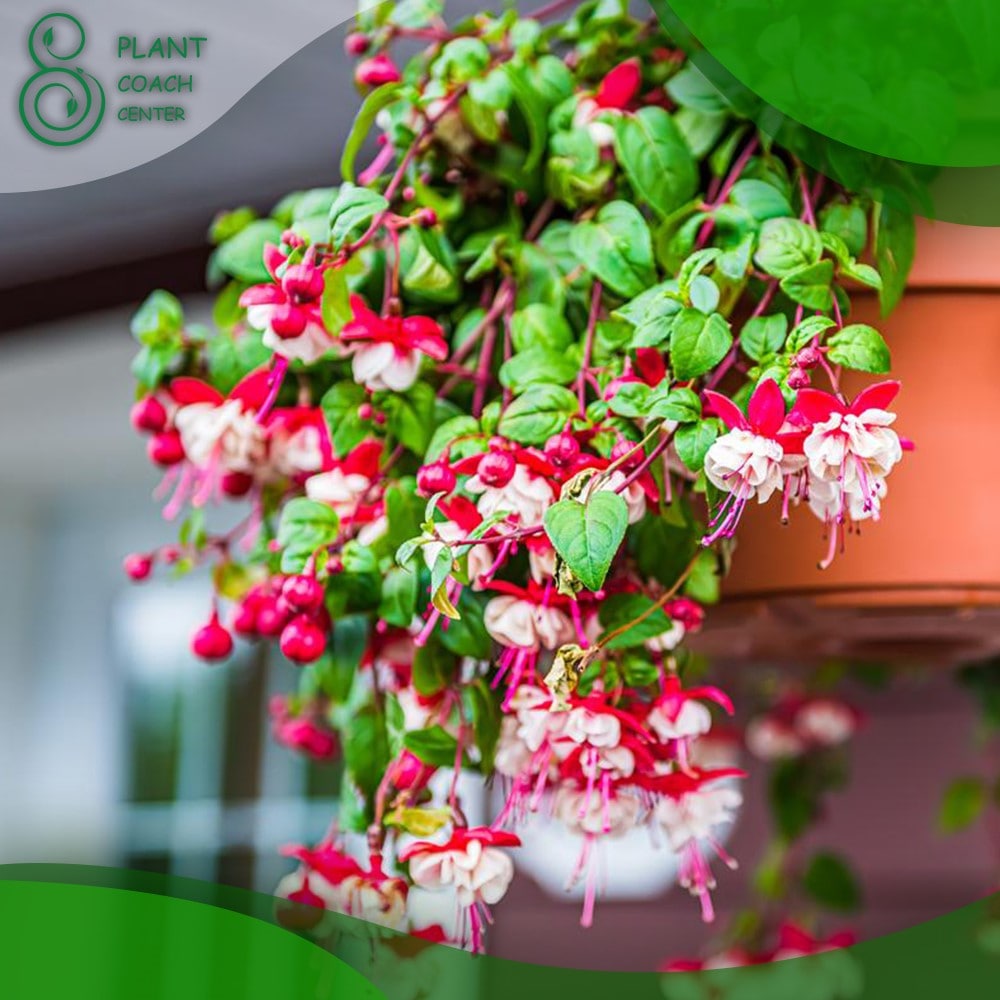When to Cut Back Fuchsias in Pots
Fuchsias are stunning flowering plants known for their delicate, pendulous blooms that come in various colors and sizes. Growing them in pots is a popular choice among gardeners as it allows for better control of their environment and enhances their aesthetic appeal. Understanding the basics of fuchsia growth and pruning is essential to maintain their health and beauty.
Fuchsia Growth and Pruning Basics
Fuchsias, like most plants, undergo a growth cycle that influences their pruning requirements. Pruning is a crucial practice that not only helps maintain the plant’s shape but also encourages new growth and abundant flowering. The key aspects of fuchsia pruning include:
- Pinching Back: This technique involves the removal of the growing tips of young shoots, stimulating branching and creating a bushier appearance.
- Heading Back: Cutting back the older stems, often in late winter or early spring, promotes fresh growth from lower nodes and helps maintain the plant’s shape.
- Thinning Out: This method entails removing older, weak, or damaged stems to improve air circulation and overall plant health.
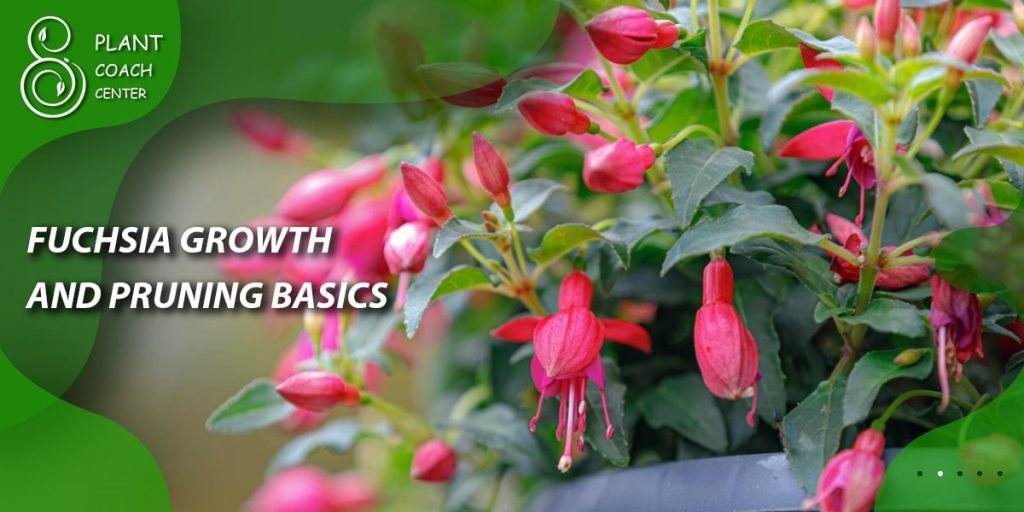
Identifying the Right Time for Pruning
Timing is crucial when it comes to fuchsia pruning. The optimal time to prune depends on various factors, including seasonal considerations and the plant’s growth patterns.
Seasonal Considerations
- Pruning in Spring: Early spring, after the last frost, is generally the best time to prune fuchsias. This allows the plant to capitalize on the growing season ahead.
- Pruning in Summer: Light pruning during mid-summer can help manage overgrowth and keep the plant tidy.
- Pruning in Fall: In milder climates, you can perform light pruning in the fall, but avoid major cuts as the plant prepares for dormancy.
- Pruning in Winter: If your region experiences harsh winters, wait until late winter or early spring to prune, as cutting back too early can make the plant susceptible to frost damage.
Reading the Plant’s Signals
Observing the fuchsia plant’s appearance and behavior can also guide pruning decisions:
- Signs of Overgrowth: If the fuchsia appears leggy, with weak stems and fewer flowers, it might be time to prune and rejuvenate the plant.
- Signs of Dormancy: In colder climates, fuchsias may enter dormancy during winter. Prune lightly to remove dead or diseased growth during this period.
Pruning Techniques for Fuchsias in Pots
Pruning fuchsias in pots requires proper technique and the right tools to achieve the desired results.
Tools and Equipment
Having the right tools ensures clean cuts and minimizes stress on the plant:
- Pruning Shears: Sharp and clean pruning shears are essential for precision cuts without crushing the stems.
- Gloves: Wearing gloves protects your hands and reduces the risk of transferring diseases between plants.
- Disinfectant: Sterilize your tools with alcohol or a bleach solution to avoid spreading diseases.
Step-by-Step Pruning Guide
- Pinching Back:
- Using your fingers or pruners, pinch off the growing tips of young shoots just above a set of leaves.
- Repeat the process throughout the growing season to encourage bushier growth.
- Heading Back:
- In late winter or early spring, identify older stems that need pruning to control the size and shape of the plant.
- Cut back about one-third of the stem’s length, just above a set of leaves or a node.
- Thinning Out:
- Inspect the plant for any dead, weak, or overcrowded stems.
- Using clean pruning shears, remove these stems at their base, improving air circulation and overall plant health.
Addressing Specific Growth Habits
- Leggy Fuchsias:
- If your fuchsia is leggy, focus on pinching back to encourage branching and create a fuller appearance.
- You can also consider heading back to rejuvenate the plant and promote fresh growth from lower nodes.
- Bushy Fuchsias:
- For bushy fuchsias, thinning out is crucial to reduce overcrowding and improve air circulation.
- Light pruning can help maintain the shape without compromising the plant’s health.
- Unbalanced Growth:
- Observe your fuchsia’s growth pattern and address any imbalances by selectively pruning to create a harmonious shape.
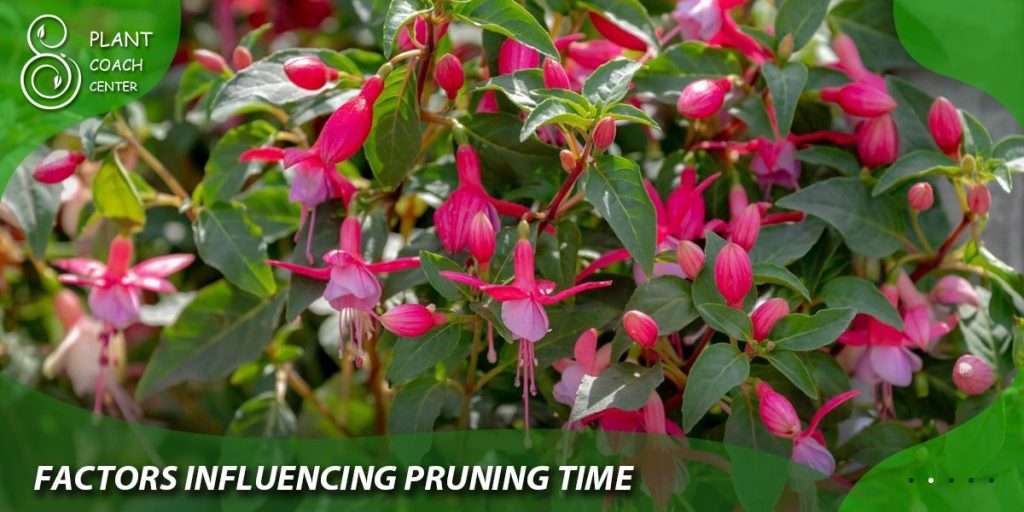
Factors Influencing Pruning Time
Several factors influence the ideal timing for pruning fuchsias in pots. Understanding these factors will help you make informed decisions for your plant’s well-being.
Climate and Geographic Location
- Hardiness Zone: Consider the hardiness zone you reside in as it dictates the plant’s growth cycle and dormancy period.
- Frost Risk: If frost is a concern in your area, avoid late-season pruning to prevent frost damage to new growth.
Fuchsia Varieties
- Cultivar Characteristics: Different fuchsia varieties may have varying growth habits and pruning needs. Research the specific requirements of your cultivar.
Container Size and Condition
- Pot Size: Smaller pots may require more frequent pruning to manage growth, while larger pots may accommodate larger plants without immediate pruning needs.
- Soil and Drainage: Ensure your potting mix is well-draining to prevent waterlogged roots, which can affect plant health and growth.
Nutrient and Water Requirements
- Fertilization: Adequate nutrition is essential for healthy growth. Follow a balanced fertilization schedule to support your fuchsia’s needs.
- Watering: Avoid overwatering, as it can lead to root rot. Adjust watering according to the plant’s needs and the surrounding climate.
Understanding Fuchsia Diseases and Pests
Fuchsia plants, like any other, are susceptible to diseases and pests. Identifying and treating these issues promptly is crucial to ensure the plant’s longevity and vibrancy.
Common Fuchsia Plant Problems
- Fuchsia Rust: Identified by yellow-orange powdery spots on the undersides of leaves, fuchsia rust is a fungal disease that weakens the plant.
- Botrytis Blight: This gray mold disease affects buds, flowers, and stems, causing them to rot and decay.
- Crown Gall: A bacterial disease characterized by swollen and distorted growths on the plant’s stems and roots.
- Verticillium Wilt: Fuchsias infected with this fungal disease show wilting and yellowing of leaves, typically on one side of the plant.
Identifying and Treating Diseases
- Fuchsia Rust:
- Remove affected leaves and dispose of them properly.
- Apply a fungicide as per the manufacturer’s instructions.
- Botrytis Blight:
- Prune infected areas and dispose of them immediately.
- Improve air circulation around the plant to reduce humidity levels.
- Crown Gall:
- Prune and destroy infected parts.
- Sterilize pruning tools between cuts to avoid spreading the disease.
- Verticillium Wilt:
- There is no specific cure for this disease. Remove and destroy the infected plant to prevent further spread.
Preventative Measures for Healthy Plants
- Proper Hygiene and Sanitation:
- Regularly clean the area around the fuchsia plant and remove fallen debris.
- Disinfect tools after each use to prevent disease transmission.
- Selecting Disease-Resistant Varieties:
- When purchasing fuchsia plants, choose cultivars known for their resistance to common diseases in your area.
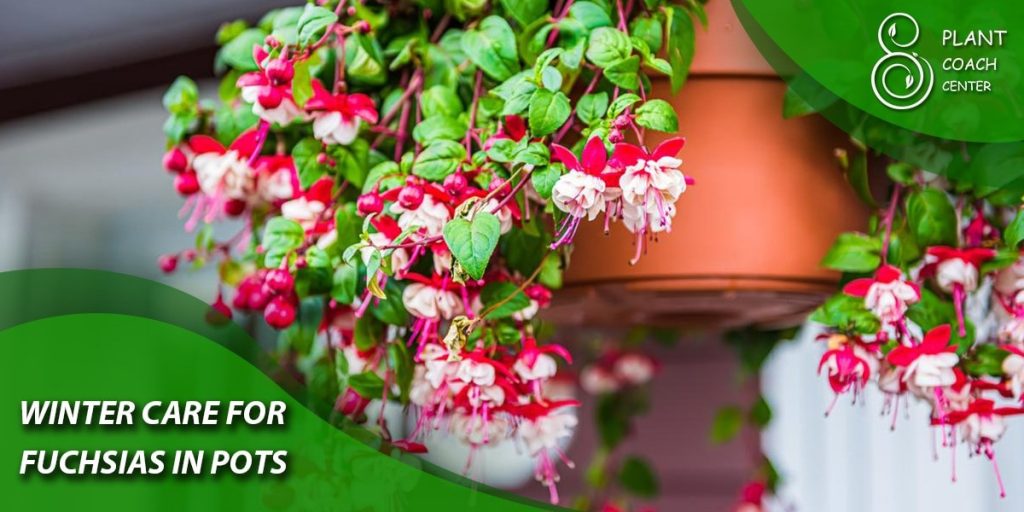
Winter Care for Fuchsias in Pots
Preparing your fuchsias for winter is essential to protect them from frost and cold damage.
Preparing Fuchsias for Winter
- Assessing Plant Health:
- Inspect your fuchsia for any signs of disease or stress.
- Address any issues before winter sets in to give the plant the best chance of survival.
- Bringing Fuchsias Indoors:
- In colder climates, consider bringing potted fuchsias indoors to protect them from freezing temperatures.
- Winterizing Outdoor Potted Fuchsias:
- Mulch the base of the plant to insulate the roots.
- Wrap the pot with insulating material to protect the root ball.
Pruning and Maintenance During Winter
- Light Winter Pruning:
- During the winter, perform only light pruning to remove dead or diseased growth.
- Avoid heavy pruning, as it can stimulate new growth that may not survive the cold.
- Watering and Moisture Control:
- Adjust watering during winter, as the plant’s water needs decrease with lower temperatures and reduced growth.
Addressing Cold Stress and Frost Damage
- Cold Stress:
- If you notice signs of cold stress, such as leaf wilting or discoloration, move the plant to a more protected location.
- Frost Damage:
- If frost damages the plant, prune back the affected parts in early spring after the danger of frost has passed.
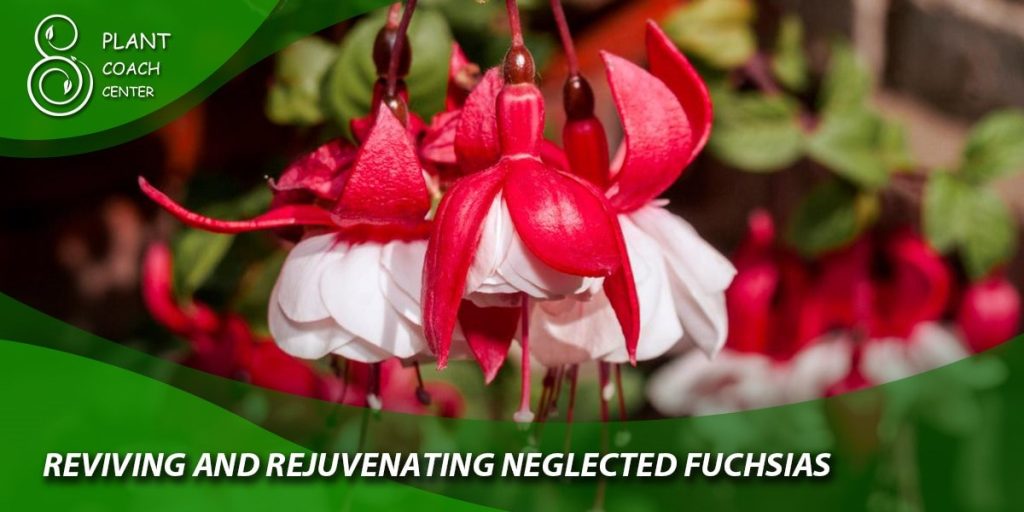
Reviving and Rejuvenating Neglected Fuchsias
Neglected fuchsias can become overgrown, leggy, and unhealthy. However, with proper care and attention, you can revive and rejuvenate these plants to restore their beauty and vigor.
Assessing Neglected Fuchsias
- Observation:
- Take a close look at the overall condition of the fuchsia, noting any signs of stress, disease, or pest infestations.
- Identify areas that require pruning and rejuvenation.
- Root Health:
- Gently remove the plant from its pot to inspect the root system.
- Healthy roots are firm and white, while unhealthy roots may appear brown, slimy, or rotted.
Gradual Pruning and Rehabilitation Techniques
- Gradual Pruning:
- Avoid drastic pruning in one go, as it may shock the plant and lead to further stress.
- Instead, opt for gradual pruning over several weeks or months to give the plant time to recover.
- Rehabilitation Techniques:
- Promote healthy growth by providing the necessary nutrients, sunlight, and water.
- Consider repotting the fuchsia into fresh, well-draining soil to improve root health.
- Support and Training:
- Use stakes or trellises to support the fuchsia as it regrows, especially if the plant has become leggy.
Restoring Fuchsia Health and Beauty
- Pruning for Rejuvenation:
- Focus on pinching back and heading back to encourage bushier growth and a more balanced shape.
- Remove any dead or diseased growth to promote new shoots.
- Fertilization and Watering:
- Feed the plant with a balanced fertilizer to provide essential nutrients for healthy growth.
- Water the fuchsia appropriately, avoiding both overwatering and underwatering.
- Sunlight and Environment:
- Ensure the plant receives adequate sunlight, typically 4 to 6 hours of indirect sunlight per day.
- Keep the fuchsia in a sheltered location to protect it from harsh winds and extreme temperatures.
Last words
In conclusion, understanding the proper timing and techniques for pruning fuchsias in pots is essential for maintaining healthy and vibrant plants. By considering seasonal factors, reading the plant’s signals, and implementing appropriate pruning methods.
you can enhance the beauty and longevity of your fuchsia plants. Additionally, addressing diseases, pests, and neglected fuchsias through proper care and rehabilitation will help you enjoy these stunning flowering plants in your garden for years to come. With dedication and a green thumb, you can master the art of fuchsia pruning and create a captivating display of colors and blooms in your potted garden. Happy gardening!
When is the best time to prune fuchsias in pots?
Early spring after the last frost.
Can I prune flowering fuchsias?
Yes, but avoid heavy pruning during the flowering season.
How much can I prune without harming the plant?
Avoid removing more than one-third of the plant's total growth in one session.


